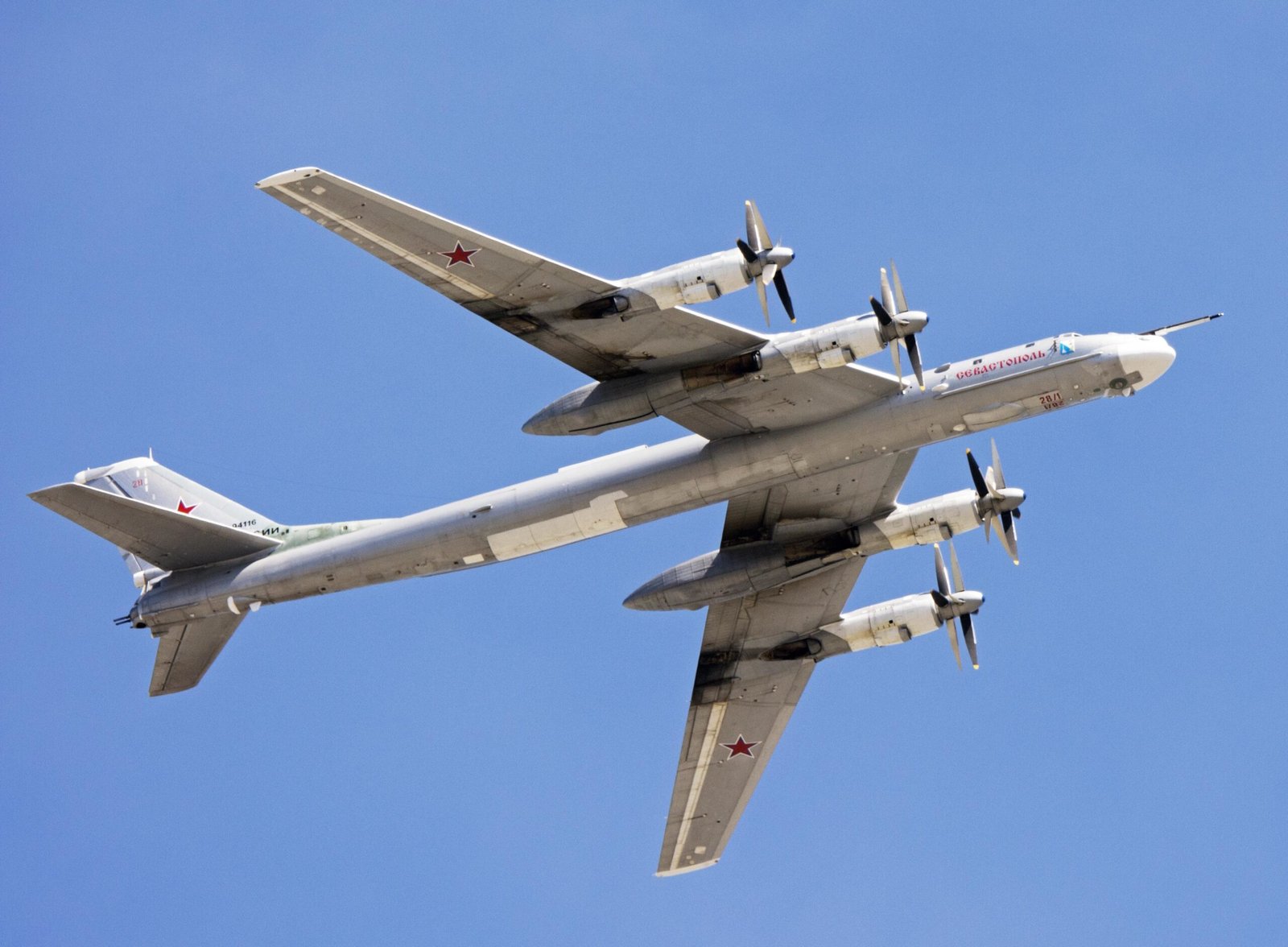The Tupolev Tu-95, a strategic bomber with a distinctive roar that echoes across the skies, stands as a testament to Soviet engineering prowess and a symbol of the Cold War. This formidable aircraft, often referred to by NATO as the “Bear,” continues to serve in the Russian Aerospace Forces, making it one of the longest-serving military aircraft in active duty.
A Legacy of Innovation
The Tu-95’s origins lie in the early 1950s, a period of intense competition between the United States and the Soviet Union. The Soviet Union sought to develop a long-range bomber capable of delivering nuclear weapons across vast distances. The result was a revolutionary design: a large, four-engine turboprop-powered aircraft with swept wings. This combination of features was unprecedented, offering a unique blend of speed, range, and payload capacity.
The Tu-95 first took to the skies in 1952, and entered service with the Soviet Air Force in 1956. It quickly became a cornerstone of Soviet strategic aviation, capable of carrying nuclear bombs and cruise missiles deep into enemy territory.
A Unique Design
The Tu-95’s most striking feature is its propulsion system. Unlike most modern military aircraft that rely on jet engines, the Tu-95 is powered by four Kuznetsov NK-12 turboprop engines. These engines drive contra-rotating propellers, meaning each engine has two propellers that spin in opposite directions. This configuration enhances efficiency and reduces drag, allowing the Tu-95 to achieve impressive speeds for a propeller-driven aircraft.
The swept-back wings of the Tu-95 are another key element of its design. This configuration reduces drag at high speeds, enabling the aircraft to fly faster and further. The Tu-95’s distinctive “whale-like” fuselage further contributes to its aerodynamic efficiency.
A Versatile Platform
Over the years, the Tu-95 has undergone numerous modifications and upgrades, evolving into a versatile platform capable of fulfilling a variety of roles.
Strategic Bomber: The Tu-95 remains a potent strategic bomber, capable of carrying nuclear weapons and conventional ordnance. It can also launch air-launched cruise missiles, extending its reach and enhancing its strike capabilities.
Maritime Patrol Aircraft: A variant of the Tu-95, the Tu-142, is primarily used for maritime patrol and anti-submarine warfare. It carries a range of sensors and weapons, including torpedoes and anti-ship missiles.
Electronic Warfare Aircraft: The Tu-95MS is equipped with electronic warfare systems, allowing it to disrupt enemy communications and radar.

Modernization and Upgrades
Despite its age, the Tu-95 continues to receive upgrades and modernization efforts. The Russian Aerospace Forces have implemented a program to modernize the existing fleet, extending their service life and enhancing their capabilities. These upgrades include:
New Avionics: The Tu-95 is being equipped with modern avionics systems, including new navigation and targeting equipment. This improves the aircraft’s accuracy and effectiveness in combat.
Engine Upgrades: The Kuznetsov NK-12 engines are being upgraded to improve their performance and reliability.
New Weapons Systems: The Tu-95 is being integrated with newer weapons systems, including more advanced cruise missiles.
The Tu-95 in the 21st Century
The Tu-95 remains a significant military asset for Russia. It continues to play a crucial role in strategic deterrence and power projection. The aircraft’s long range and endurance allow it to operate over vast distances, projecting Russian influence and demonstrating its military capabilities.
However, the Tu-95 also faces challenges in the modern era. Newer, more advanced aircraft, such as the Tu-160 and the Tu-22M3, offer improved performance and stealth capabilities. Nevertheless, the Tu-95’s unique combination of speed, range, and payload capacity ensures its continued relevance in the foreseeable future.
The Tu-95’s Impact on Aviation
The Tu-95 has had a significant impact on aviation history. Its innovative design, combining turboprop engines with swept wings, pushed the boundaries of aeronautical engineering. The aircraft’s success demonstrated the potential of turboprop propulsion for large, long-range aircraft.
The Tu-95’s legacy extends beyond its military applications. The aircraft’s robust and reliable design has inspired other aircraft developments, and its impact on aviation technology continues to be felt today.
Legacy and Future
The Tu95 is a testament to Soviet engineering prowess and a symbol of the Cold War era. Its unique design, exceptional range, and versatility have ensured its continued relevance in the 21st century.
The Russian Air Force plans to keep the Tu-95 in service for the foreseeable future. Upgrades and modernization programs are ongoing, ensuring that the aircraft remains a potent weapon system. The Tu-95’s distinctive roar is likely to be heard for many years to come, reminding the world of its enduring legacy.
Final Thoughts
The Tu-95, a Cold War relic roaring into the 21st century, stands as a testament to human ingenuity and the enduring power of innovation. This formidable aircraft, with its unique design and impressive capabilities, continues to serve as a potent symbol of Russian military might. As the world evolves, the Tu-95’s role may change, but its place in aviation history is secure.
FAQs
What are the key upgrades and modifications incorporated into the Tu-95MS and Tu-95MSM variants?
The Tu-95MS and Tu-95MSM represent significant advancements over earlier versions. These modernized variants feature a suite of enhancements, including upgraded avionics systems with improved navigation and radar capabilities, advanced electronic warfare suites to counter enemy threats, and the integration of air-launched cruise missiles such as the Kh-55SM and Kh-101. These upgrades significantly expand the aircraft’s strike capabilities and enhance its overall combat effectiveness.
How does the Tu-95 contribute to Russia’s military strategy?
The Tu-95 continues to play a vital role in Russian military strategy. It serves as a cornerstone of Russia’s nuclear deterrent force, capable of delivering nuclear weapons to targets across the globe. Furthermore, long-range patrols conducted by the Tu-95 demonstrate Russia’s military reach and project a message of strength on the global stage. With the integration of modern cruise missiles, the Tu-95 also possesses significant conventional strike capabilities, enabling it to engage ground and maritime targets.
What are the challenges facing the continued operation and maintenance of the Tu-95?
As an aging aircraft that has been in service for decades, the Tu-95 faces several challenges. Maintaining an aging fleet requires significant resources for ongoing maintenance, upgrades, and the procurement of spare parts. The emergence of newer, more technologically advanced aircraft also poses a challenge, necessitating continuous modernization to ensure the Tu-95 remains relevant and effective in the modern military environment.
To read more, Click Here












Leave a Reply